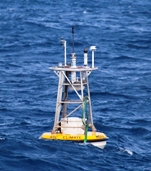
Increased monitoring ability will enable better monitoring of plants' response to different environments.
Researchers at the University of Missouri have found methods to help farmers reduce greenhouse gas emissions while also increasing corn grain production.

The Institute's State of the World report provides a roadmap for food security and agricultural investment, noting benefits for the planet on the way.
The power generation company's contribution pushes its financial commitment to $2.3 million in five years.

Company expands existing weather networks to monitor and measure greenhouse gases all over the world.
A three-year deferral allows for further examination of scientific and technical issues associated with counting these emissions, EPA says.
The amount of dust in the Earth’s atmosphere has doubled since the beginning of the 20th century and the dramatic increase is influencing climate and ecology around the world.
More plant matter could be burned in coal-fired power stations if this 'green' fuel was delivered pre-roasted like coffee beans, according to researchers from the University of Leeds.
Ritter will head a new national policy center focused on building the new energy economy.
Professors examine significant legal responses to such topics as climate change, the Deepwater Horizon oil spill, and greenhouse gas rules.
Billfish and tuna, important commercial and recreational fish species, may be more vulnerable to fishing pressure because of shrinking habitat according to a new study.
The non-profit business will involve 100 percent organically grown and recyclable products, local suppliers, Energy Star appliances, and both solar hot-water heating and solar photovoltaic technologies.
A new methodology to assess the potential to store carbon in U.S. wetlands, forests, and rangelands ecosystems – and thus to reduce emissions of greenhouse gases to the atmosphere — will help find ways to mitigate the impacts of climate change.
U.S. Secretary of the Interior Ken Salazar approved the Record of Decision (ROD) for the Crescent Dunes Solar Energy Project located in Nye County near Tonopah, Nev.

Washington University study is tweaking the catalyst to complete the methane to ethane reaction.

A novel project that uses cameras mounted on unmanned aircraft flying over the Arctic is serving double duty: Not only is it assessing the characteristics of declining sea ice, but it’s also using the same aerial photos to pinpoint seals that have hauled up on ice floes.

To better understand the effects of the ocean on global climate and weather, scientists from NOAA’s Pacific Marine Environmental Laboratory deployed an ocean climate station mooring — an anchored buoy — on the edge of the warm Agulhas Return Current southeast of South Africa.
The project, slated to commence operation in early summer 2011, will have the initial capacity to generate 42,000 megawatt hours of electricity per year, enough to power 2,800 homes.
The EPA has awarded $5 million to the Southern Alliance for Clean Energy to help Southern truckers and businesses buy cleaner big rigs.
This next-generation feed-in tariff program will require investor-owned California utilities to purchase electricity from solar and other renewable energy systems up to 20 MW in size.